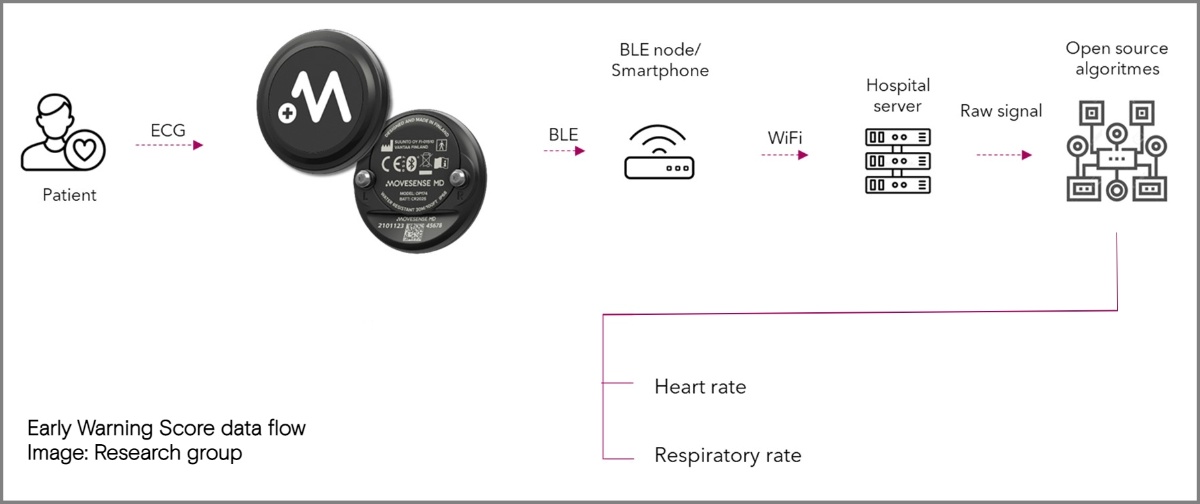Movesense Academic Program Expands – Monitoring Cervical Dystonia and Patient Early Warning Score

Movesense Academic Program is an initiative of Movesense and its development partner Kaasa Solution to support scientific research projects with high quality sensors and data collecting tools for physiology and biomechanics.
New projects are invited to the program based on applications. We are excited to announce that two new health-related projects joined the program in December:
Cervical Dystonia – objective assessment of symptoms based on sensor data
Jožef Stefan Institute, Ljubljana, Slovenia
Cervical dystonia is a chronic neurological movement disorder that involves involuntary, prolonged or twisting repetitive neck movements caused by increased muscle activity. It is an extremely stigmatizing and painful chronic disease that has no curative treatment at the moment.
Symptoms of cervical dystonia are treated with botulinum toxin injections to affected neck muscles based on visual assessment of a neurologist. The neck movements are often changing in direction, speed, frequency and amplitude. This means that the muscles responsible for the movement change over time. Correspondingly, the botulinum toxin injection site must also be constantly adjusted.
Currently, there are no measurement tools for monitoring cervical dystonia. Patients often report that their symptoms (involuntary movement direction and tremor) change over time, making one-time assessments in the clinic especially difficult.
Wearable sensors that enable patients to be monitored at home could significantly improve the situation. With sensors like Movesense, physicians could assess symptoms faster and more precisely also in the clinical environment. This would be of significant benefit in optimizing treatment and reaching better patient outcome.
A collaboration project between the Institute of clinical neurophysiology (ICN) at the University medical center Ljubljana and the Computer systems department at the Jožef Stefan Institute (JSI) in Ljubljana, Slovenia, aims at developing such a measurement solution. The project will use multichannel EMG and Movesense sensors to build models of healthy and affected behavior of neck muscles and to predict muscle activity based on data from two Movesense sensors placed on the body of the patient. The team expects that the results of the project will help to get better results from the treatment of cervical dystonia than before.
Feasibility study of the analysis of ECG signals by open source algorithms for Early Warning Score calculations
University of Ghent, AZ Maria Middelares hospital, Ghent, Belgium
Acute deterioration in critical ill patients is often preceded by changes in physiological parameters, such as pulse, blood pressure, temperature and respiratory rate. If these changes are recognized early, excess mortality and serious adverse events such as cardiac arrest may be prevented.
The Early Warning Score (EWS) is a scoring system that helps detect physiological changes and may help identify patients at risk of further deterioration. The score is calculated based on five vital parameters, i.e. respiratory rate, heart rate, blood pressure, body temperature and awareness.
Measuring these parameters manually is time-consuming. Some of the actions have been automated but manual work is still required in the current system. Nurses must visit all patients three times a day to measure the vital parameters. Especially the measurement of respiratory rate is time-consuming, complex and leaves room for errors. Analysis of the current EWS showed that the complexity of measuring respiratory rate leads to errors in the EWS. This may even alter the patient care.
However, respiratory rate is one of the most predictive parameters for early deterioration of the patient’s condition. The research team has previously carried out several tests with different techniques to measure vital parameters. Due to high cost or inaccuracy, these technologies are no longer used.
In the current study, the team will use Movesense Medical sensor to collect ECG data from the patients. The team will use open-source algorithms to detect heart rate and respiratory rate from the ECG signal and validate the results. If the vital parameters calculated by the algorithms prove to be sufficiently accurate, the hospital’s intention is to introduce a continuous EWS monitoring system throughout the hospital. The featured image shows the overall data flow of the system.
Welcome aboard!
Movesense team warmly welcomes both projects to the program. We are proud to support these initiatives, which in the future can improve treatment outcomes for many patients.
Read more about the wearable, programmable Movesense Medical ECG and movement sensor.
To learn how you can use Movesense sensors for your own commercial or research projects, don’t hesitate to get in touch with our experts:
